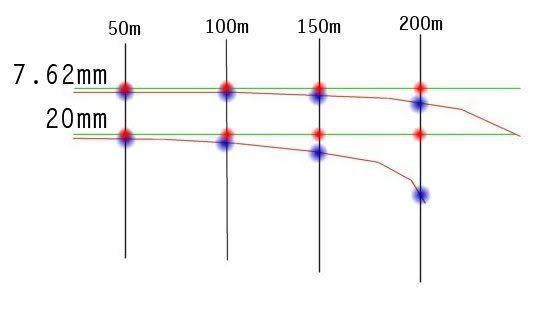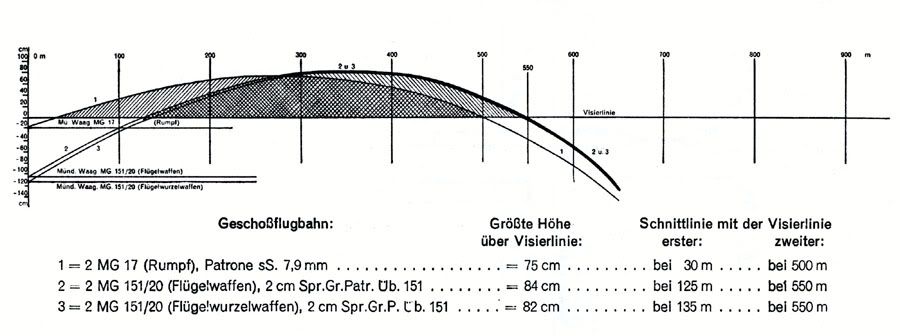
 |
|
|
|
#1
|
|||
|
|||
|
Yes it is. Its the same as horizontally range.
__________________
 ---------------------------------------------- For bugreports, help and support contact: daidalos.team@googlemail.com For modelers - The IL-2 standard modeling specifications: IL-Modeling Bible |
|
#2
|
|||
|
|||
|
I've seen that bullets fall as they fly... but if convergence is set to... say 1000m, shouldn't the bullets describe an arc above the reticle, so as to cross the sight at 1000m?
I haven't seen this effect in the game, that's why i'm asking. It's an important factor when fighting against level bombers. Again, I may be mistaken, just trying to confirm.
__________________

|
|
#3
|
|||
|
|||
|
They do fly in an arc.
__________________
Why do some people tend to take it for granted that others have poorer knowledge background than themselves regarding the argument while they actually don't have a clue who they are arguing with in the first place? 
|
|
#4
|
|||
|
|||
|
Ok, me bugging again. I can be a nuisance, I know.
But please bear in mind that i'm just concerned about the things that could be improved in a future release. So this is not plane criticism, I really appreciate the work TD has done so far and I'm confident that the game will get even better thanks to them. And of course I'm ready to aacept that I'm wrong on this one. What I see in the game is this:  What I think it should be is this:   But again, I have been wrong so many times that once again won't have much impact
__________________

Last edited by [URU]BlackFox; 02-29-2012 at 09:04 PM. |
|
#5
|
|||
|
|||
|
Yes. You can easily see this if you look at tracks of planes firing low muzzle-velocity guns from a stationary view.
For that matter, you test it yourself. Aim directly at a non-maneuvering target 600 meters out at your 12 o'clock level. Shoot a long burst. Quickly switch to exterior enemy view (Ctrl-F2). Watch the bullets pass beneath your target. Or just fly straight, slow and level over water. Shoot your guns. Watch as the bullets hit the water. |
|
#6
|
|||
|
|||
|
Well, considering the longest distance that you can set your convergence in the game is 1000 metres, the bullets won't rise all that much above the aiming line at that time.
If you want the maths, here goes: The muzzle velocity of most weapons in the game is somewhere between 500-1000 m/s: 540 m/s for MK108 720 m/s for MG151/20 850 m/s for Browning .303-cals 890 m/s for Browning .50-cals 960 m/s for MG151/15 The bullet drop distance is simple to calculate: y = ½ g t² where g = 9.80665 m/s² t = bullet travel time Notwithstanding the drag that the bullet experiences, which slows its velocity, we can still get some guidelines by assuming that the bullet travels at its muzzle velocity the entire way from the muzzle to the target. So if we look at the slowest projectile here, MK108 grenade, and assume that the average velocity is something in the order of 500 m/s, we can determine that the travel time for 1000 metres convergence is two seconds. Now we substitute this in the equation to determine how much the bullet falls during this time: y = ½ * 9.80665 m/s² * (2 s)² = ½ * 9.80665 * 4 m = 19.6 metres Now, to get how much higher the bullet must arc, you can divide this by two since the bullet first goes up, then down. So, with the MK108 cannon, firing at level attitude to 1000 metres distance at 1000 metres convergence, the projectile should have peak altitude about 10 metres higher than the aiming line. At 500 metres distance, 10 metres deviation above the aiming line is not easy to see, in fact on the computer screen it is not very many pixels; a single seat fighter aircraft's wingspan (or length) are of the same order of size, so there's your measure stick. Note that the MK108 cannon is rather slow and you probably stand no chance of either hitting anything at that distance, or to accurately see the projectile arcing higher than the aiming line because the recoil will probably throw your sight around quite a bit. With the faster projectiles, the effect is even less pronounced. The MG151/15 cannon projectile should pass the distance of 1000 metres in close to one second, and in that time, the projectile drop is only about five metres, and the peak altitude above aiming line is half that - 2.5 metres or close to that. With MG151/20 projectile, you have muzzle velocity of 720 m/s; using nice round numbers we can say the average velocity for the projectile might be something around 700 m/s. That translates to about 1.43 seconds of flight time; rounding up let's say 1.5 seconds. 1.5 seconds gives a bullet drop of about 11 metres, and thus the peak altitude would be around 5.5 metres above aiming line. Now, I don't know exactly HOW much the drag affects projectiles in distances below 1000 metres. If it's modeled physically accurately, then the heavier projectiles should technically retain their speed better while the smaller projectiles would decelerate faster due to their higher dragcoefficient/mass ratio (small stones have lower terminal velocity than big stones of same shape and density), but I don't think it will have that much of an effect on this rudimentary mathematics. The point is, since maximum convergence distance is 1000 metres, the projectiles won't arc very much above the line of sight, with exception of the slowest projectiles. The situation would be different if you could set convergence to, say, 2000 or 3000 metres, but then this would only be useful if we had an A-10 Warthog in the game with its GAU-8 cannon... |
|
#7
|
|||
|
|||
|
I see now. Thanks a lot for the explanation. I really thought the vertical correction was more significant.
__________________

|
|
#8
|
|||
|
|||
|
@Black Fox:
Thats quite funny since you posted those documents. See the 2nd one? That part with "Größte Höhe über Visierlinie" (75; 84; 82cm). This translates into "max height (of bullet's flightpath) above your line of (aiming) sight. Those MG rounds pass the LOS the 1st time at 30m and the 2nd time (when falling down) at 500m. Between 30m and 500m the max height above the LOS are those 75cm. Since this is obviously not a conv of 1000m it isn't that much and pretty much reflects what Herra Tohtori said. |
|
#9
|
|||
|
|||
|
Quote:
If those numbers are correct (which I have to assume at this moment) the bullet of a MG151/20 in the wingroot of a FW190A aimed at a spot 550m away starts out about 120cm below the aiming line, crossing it for the first time at 135m distance, then actually climbs up to 84cm above the aiming line (2.04m traveld upwards) where it will be at around 350m distance, before falling back to the aiming line and meeting it a second time at 550m. This numbers actually show that Herra Tohtoris simplified math isn't far off for (relative) short distances. However if the distance becomes longer the projectile becomes slower and the drag becomes less marginal. |
|
#10
|
|||
|
|||
|
http://forums.ubi.com/showthread.php...%28s%29-Forums
MG151/20 ballistics for different shell types. Notice the gun isnt a factory fresh one but already seen some use. |
 |
|
|